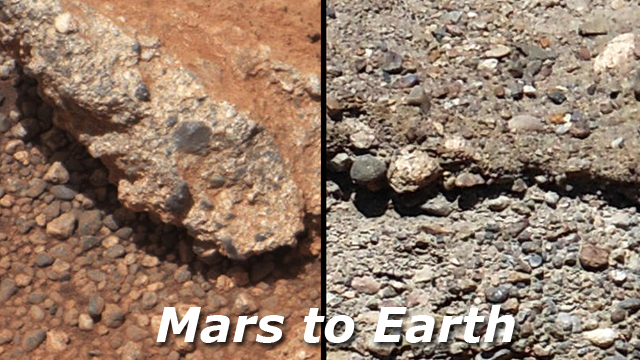
The news from Mars just keeps getting better. NASA's Curiosity rover, now exploring the alluvium at the base of Mount Sharp in Gale Crater for over two months, has struck pay dirt: the gravel and river stone conglomerate laid down by an ancient Martian stream!
Hearing that bit of news was tantalizing, and seeing the photographic evidence a true thrill for someone who loves scratching around in the rocks and sand of the desert, looking for signs and clues of the geologic history of the place. Death Valley is my favorite hunting ground for signs of water--and why, you might ask, would I go looking for water in a desert? To that I would answer, looking for signs of water in a lake or river is just too darned easy.
The pictorial evidence in question is a bed of gravel and rounded stones bound together by finer material that has solidified over time. The conglomerate rock is similar to examples of sediment found on Earth: solid layers a lot like very coarse concrete. The materials were washed down by river or stream action, transported from the locations where they originally eroded, and in the process of tumbling along with the flow the larger stones becoming rounded and smoothed.
On Mars, at the site of Curiosity's find near the bottom of a large alluvial fan (the pile of material deposited by stream action at the bottom end of a downhill flow), the layer of conglomerate material has been broken and upturned for the rover to see and examine—possibly by a meteorite impact in the past. Were it not for whatever had broken and exposed the layer, Curiosity's wheels may have rolled right over it, inches from the great find but unaware of it laying there under topsoil. From the size and appearance of the rocks in the conglomerate—from sand grain to golf ball sized—scientists estimate that the water which deposited the material probably moved along at a speed of three feet per second, and was anywhere from a few inches to two or three feet deep.
I recall some interesting formations out in the deserts of Northern Arizona, where I lived for a few years, which the Curiosity report from NASA reminded me of. In one particular spot, somewhere east of Flagstaff and maybe west of Winslow, are what I call "petrified rivers". Snaking around the flat desert just off the north shoulder of Interstate 40 is a winding network of raised "roadways" of rock, rising a foot or two off the ground and meandering about in the pattern of flowing streams. I learned that these features are sedimentary conglomerate rock laid down by streams that flowed there in the past and solidified over time. Then, long after the water stopped flowing as the region dried out, erosion by wind and rainfall gradually wore away the softer surrounding soils, leaving the harder streambed conglomerates intact, exposed for anyone passing on the Interstate to see and wonder about.